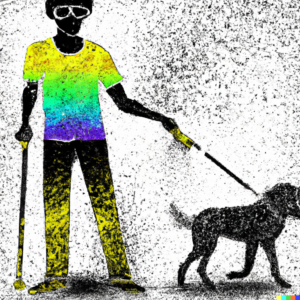Visual description is a verbal description of visual elements in a piece of media, such as a movie, television show, or artwork, that is provided for the benefit of people who are blind or have low vision. The purpose of visual description is to allow people with visual impairments to understand and appreciate the visual aspects of the media, as they would not be able to see them otherwise.
Seven key best practices to follow when doing visual descriptions:
- Be accurate and objective: Visual descriptions should accurately and objectively describe the visual elements of the media. Avoid adding personal opinions or interpretations.
- Be concise and clear: Keep descriptions concise and use clear language. Avoid using jargon or overly technical terms.
- Use concrete and specific language: Use concrete and specific language to describe the visual elements, rather than abstract or general terms. For example, “the character is wearing a red shirt” is more descriptive than “the character is wearing a bright colored shirt.”
- Describe the most important visual elements first: Start by describing the most important or prominent visual elements, and then move on to less important or background elements.
- Use good pacing and timing: The pace and timing of visual descriptions should match the action on screen. Avoid rushing or dragging out descriptions.
- Use appropriate tone: Use a neutral and matter-of-fact tone when doing visual descriptions. Avoid using sarcastic or humorous tones.
- Test and revise: It can be helpful to have someone with a visual impairment test and provide feedback on the visual descriptions to ensure that they are effective and accurately convey the visual elements of the media.
A Comprehensive Guide
for Visual Descriptions
Performance Notes for Visual Descriptions:
Addressing Self-Consciousness: Some individuals may feel self-conscious when describing themselves visually. It is essential to create a supportive and non-judgmental atmosphere, emphasizing that the purpose of visual descriptions is to foster inclusivity and understanding.
Only Provide Necessary Information: Encourage speakers to focus on relevant details such as hairstyle, hair color, race/ethnicity, gender, clothing description, distinctive accessories, and mobility aids. Remind them to avoid subjective statements, comments on attractiveness, or insignificant visual details.
Resist the Urge to Editorialize: Emphasize the importance of objective and unbiased descriptions. Remind speakers to refrain from expressing personal opinions or subjective interpretations while providing visual descriptions.
Understanding Visual Descriptions:
Definition: Visual descriptions involve describing one’s physical appearance and providing contextual information on visual elements for the benefit of visually impaired individuals or those joining via audio only channels.
Benefits: Visual descriptions help visually impaired individuals identify speakers, recognize people during interactions, and establish a mental image for future reference. Additionally, they can foster a sense of inclusivity and reduce discomfort in asking for details. We have found that this accessibility also aids those who are not disabled and are joining through audio only channels.
Providing Effective Visual Descriptions:
Verbal Introduction: Incorporate visual descriptions during your verbal introduction. Start by sharing your name, followed by a concise and informative description of your physical appearance.
Captioned Presentations: If your photo is included in a presentation, ensure it is accompanied by a visual description (also known as an image description). Mention the description when discussing visual content on the screen.
Program or Guide: When photos of speakers are included in a program or guide, provide visual descriptions alongside them to offer a visual reference for visually impaired individuals.
Audio Description: For pre-recorded events, consider having a narrator provide a visual description of the speaker as part of the additional narration track.
Key Elements to Include in Visual Descriptions:
Hairstyle and Hair Color: Describe the style and color of your hair to provide a visual reference.
Race/Ethnicity: Mention your racial or ethnic background to further assist visually impaired individuals.
Distinctive Accessories: Mention any notable accessories, such as glasses, jewelry, or other accessories that contribute to your visual appearance.
Mobility Aids: If applicable, include information about mobility aids, such as guide dogs, wheelchairs, blindness canes, or hearing aids.
Considerations and Avoidances:
Attractiveness and Commentary: Avoid comments related to attractiveness or making subjective statements about appearance.
Eye Color: Since eye color is not particularly helpful for visual understanding, it can be omitted.
Body Measurements and Clothing Sizes: Exclude detailed body measurements or clothing sizes from visual descriptions.
Minor Visual Details: Avoid mentioning minor details like a zit or small imperfections.
Clothing Brands: Unless a clothing brand represents a distinctive style, there is no need to mention specific brands.
Unnoticeable Visual Details: Exclude visual details that would go unnoticed by sighted individuals.
Description Length: Keep the visual description concise, generally within a 30-second timeframe.

